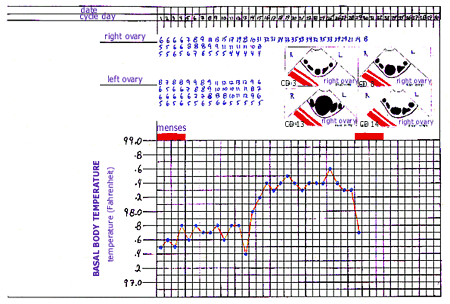| visit: www.infertilitytutorials.com |
|
Serial Ultrasound Exams
Transvaginal ultrasonography is exquisitely able to detect small changes in the diameter of ovarian cysts. Serial ultrasound examinations are able to track the sizes of ovarian follicles throughout the pre-ovulatory (follicular) phase of the menstrual cycle, can (often) detect the collapse of the dominant follicle at ovulation, and then can identify that the collapsed (egg producing follicular) cyst has reaccumulated with fluid to become the progesterone producing corpus luteum cyst (following ovulation). The optimal time interval between ultrasounds is determined largely by the desired goal. Clinically, women who have a difficult time determining when they ovulate (using less involved techniques) may initiate ultrasound exams several days prior to the (general) time of expected ovulation. The lead follicle will often grow (in diameter) about 1-3 mm a day as it approaches ovulation during a natural (spontaneous) cycle. Therefore, in these situations an ultrasound exam every 1-2 days as ovulation approaches is reasonable. The lead follicle can also be triggered to ovulate with an injection of hCG (5,000 IU or greater) once the follicle has an average diameter of 16mm or greater (I usually wait until about 18mm). Ovulation occurs fairly reliably about 36-40 hours after the hCG trigger. In this way, one can control difficult cycles and time procedures like intrauterine inseminations. Researchers can determine when ovulation occurs reliably with serial ultrasounds that are performed several times a day. The LH surge may be determined with blood work and once this surge occurs the frequency of ultrasound exams can be increased. In a natural cycle, the lead follicle will often trigger the LH surge when it is about 25 5 mm diameter. Frequent ultrasounds attempt to determine when the lead follicle collapses (as the egg is released into the pelvis).
| |||||||||||||||

